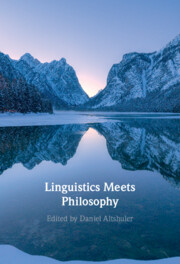Book contents
- Linguistics Meets Philosophy
- Linguistics Meets Philosophy
- Copyright page
- Contents
- Figures
- Tables
- Contributors
- Linguistics Meets Philosophy: A Historical Preface
- Introduction
- Part I Reporting and Ascribing
- Part II Describing and Referring
- Part III Narrating and Structuring
- Part IV Locating and Inferring
- Part V Typologizing and Ontologizing
- Part VI Determining and Questioning
- 11 Vagueness and Discourse Dynamics
- 12 Alternatives
- Part VII Arguing and Rejecting
- Part VIII Implying and (Pre)supposing
- Index
- References
12 - Alternatives
from Part VI - Determining and Questioning
Published online by Cambridge University Press: 06 October 2022
- Linguistics Meets Philosophy
- Linguistics Meets Philosophy
- Copyright page
- Contents
- Figures
- Tables
- Contributors
- Linguistics Meets Philosophy: A Historical Preface
- Introduction
- Part I Reporting and Ascribing
- Part II Describing and Referring
- Part III Narrating and Structuring
- Part IV Locating and Inferring
- Part V Typologizing and Ontologizing
- Part VI Determining and Questioning
- 11 Vagueness and Discourse Dynamics
- 12 Alternatives
- Part VII Arguing and Rejecting
- Part VIII Implying and (Pre)supposing
- Index
- References
Summary
The notion of ’alternative’ is central to analyses of various semantic/pragmatic phenomena, such as disjunction, focus, discourse structure, questions, and implicature. However, basic questions concerning the various notions of alternatives have not received the attention they deserve, e.g. what exactly these notions signify, or how they are supposed to interact. This chapter reflects on such questions, centering on appeals to alternatives in characterizations of focus, disjunction, discourse goals (questions under discussion), and interrogatives. More precisely, this chapter criticizes the conflation of the set of focus alternatives with the meaning of an interrogative, discusses two conceptions of the alternatives introduced by disjunction (algebraic and attention-based), and departs from the predominant view of QUDs as, essentially, linguistic questions that represent discourse goals.
- Type
- Chapter
- Information
- Linguistics Meets Philosophy , pp. 358 - 380Publisher: Cambridge University PressPrint publication year: 2022



